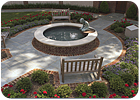
For the design of the Cannon Chapel Memorial Garden at the University of Richmond in Virginia, which serves as a columbarium space, a worship garden and a formal gathering area, slate was installed as paving to add contrast and interest to the space.
The Cannon Chapel Memorial Garden at the University of Richmond in Virginia, serves as a columbarium space, a worship garden and a formal gathering area for weddings, funerals and other special events - all uses that the client felt were needed within close proximity to the chapel. Higgins & Gerstenmaier, the landscape architects for the project, met with the University in 1998 to begin the master plan to transform the space that formerly served as an entrance to the chapel. To add contrast to the adjacent brick-faced chapel, slate paving was utilized in the garden area, as well as granite and limestone features. The overall aim of the project was to provide a design that respects existing architecture and natural space. “The goal was really to create a 3,000-niche columbarium for the alumni and people that were related to the school in some way,” said architect Craig Reichbauer of Higgins & Gerstenmaier. To help meet the desired aesthetic, approximately 2,000 square feet of Mystic River slate from Luck Stone Corp. of Richmond, VA, was utilized for paving throughout the garden. “We used a random ashlar pattern that was set up on a grid which was parallel to the chapel itself,” said Reichbauer. According to John C. Grubb, CSI, of Luck Stone Corp., natural cleft paving was used front and back, and the material features sawn edges. Furthermore, pieces range from 11 ½ x 11 ½ to 23 ½ x 35 ½ inches. “The decision to use slate was really because it related so well to the granite face we had in place,” explained Reichbauer. “The 1-inch-thick granite that is set into these walls has a light color, and the slate paving was contrasted with the brick that matches the chapel itself. In the end, the slate went really well with that. There was just so much brick, and we needed some contrast and something with a little bit more interest. “In our initial design, we weren’t planning on using slate,” Reichbauer continued. “During construction, when we submitted the original brick paving material, the owner said it just didn’t look right with the chapel. We looked at different types of material - different colors of brick and also considered Bluestone. This particular slate looks like Bluestone, but the color is more consistent and is more of what the client wanted.” Furthermore, the space is enclosed by a curved 8-foot-high brick wall with limestone caps carefully designed to match the chapel’s architectural detail. A design statement from Higgins & Gerstenmaier states, “By utilizing perimeter walls to contain the space and to house the columbaria, the focus is drawn off the columbaria and directs attention to the fountain, seating, sculpture and the overall space itself. The combination of flexible seating, the sound of water and the interplay of nature, and architecture creates a peaceful, relaxing experience for all visitors.” Columbaria niche fronts on the garden walls are comprised of thermal finished Iridian granite. The material was supplied by Eickhof Columbaria, LLP, of Crookston, MN, and quarried by Cold Spring Granite Co. of Cold Spring, MN. Furthermore, the wall caps feature limestone carved to match the existing limestone on the chapel. Architectural Stone Products, Inc. of Fredericksburg, VA, supplied and fabricated these pieces. The owner’s representative, Director of University Facilities, John Hoogakker played a very hands-on, key role throughout design and construction, according to Reichbauer. One challenge the landscape architects faced was to maintain uninterrupted use of the chapel itself during construction, as it is often used for special events planned well in advance. According to Higgins & Gerstenmaier, careful project phasing initially seemed to be the best way to minimize conflicts. However, after several phasing studies, it was decided to build the entire project at once, turning the phasing challenge into a construction challenge. Throughout construction, the “Bride’s Walk,” which leads from the chapel dressing room to the chapel entrance, was cleaned and secured every Friday for weddings, then covered and protected every Monday for construction. Furthermore, the space was, and still is, home to “Peggy’s Garden,” a small paved area with stone benches placed in memory of Peggy Meadows, a dedicated and loved employee of the university. “A precise and complete construction document package allowed the contractors to finish Cannon Garden with virtually no changes to the original design,” according to a design statement from the architects. “This, combined with the expert craftsmanship of the contractors and the design team’s careful selection of limestone and masonry materials, makes the columbarium look as if it were finished when the Cannon Chapel was completed in the 1920s.” According to the landscape architect, the client loved the end result. “In fact, the project has been an inspiration for a lot of other columbarium projects that we are working on,” he said. “A lot of our other clients look at it to get ideas for their own projects.”